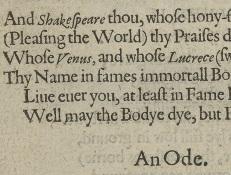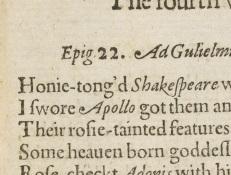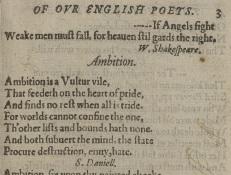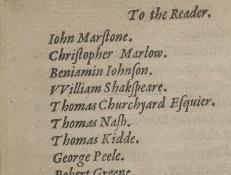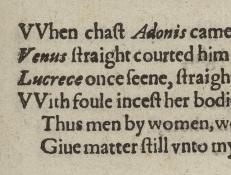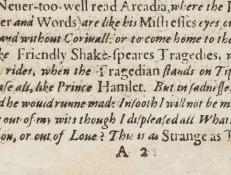To view a sortable list, please visit the Resource
All Documents
1594
Epicedium, a brief quarto pamphlet made up of only a single poem in memory of Lady Helen Branch, contains one of the earliest allusions to Shakespeare’s Lucrece by name.
1594
The first known printed reference to Shakespeare appears in a commendatory poem introducing the poetry collection Willobie his Avisa, printed in 1594. The poem, entitled “In praise of Willobie his Avisa, Hexameton to the Author,” appears before the main text.
1594
Richard Barnfield’s description of “earth-delving conies” in The Affectionate Shepheard is most likely an early allusion to the “earth-delving conies” in Shakespeare’s Venus and Adonis (1593),
1598
The first description of a performance of Love’s Labor’s Lost appears in a sonnet sequence by Robert Tofte printed in 1598, the same year the play was first published.
1598
In “A Remembrance of some English Poets,” the poet Richard Barnfield praises Edmund Spenser, Samuel Daniel, Michael Drayton, and Shakespeare.
1599
John Weever’s Epigrammes in the oldest cut, and newest fashion was published in 1599. Weever began his career as an aspiring poet and literary observer at Cambridge, where he was the student of William Covell at Queen’s College.
1600
Englands Parnassus is one of two printed commonplace books, or collections of extracts organized by topic, compiled by Robert Allott, and was printed shortly after John Bodenham’s Bel-vedére.
1600
Like other plays from the period, Shakespeare's plays were meant to be read both as stories and as sources for sententiae, or memorable aphorisms.
1600
Not all contemporary allusions to Shakespeare were positive. In the second stanza of Tom-Tel Troths Message (1600), John Lane commands his pen to “In mournfull verse lament the faults of men,” particularly in England.
1604
In 1604, Thomas Creede printed a volume of poetry called "Daiphantus, or the Passions of Love" for publisher William Cotton. The author is identified on the title page as "An.





